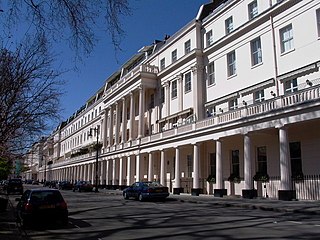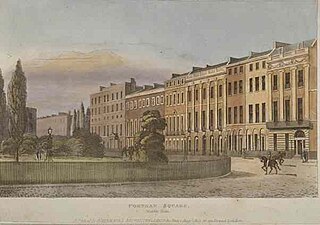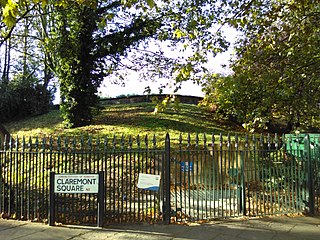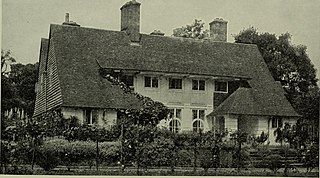Canonbury is a residential area of Islington in the London Borough of Islington, North London. It is roughly in the area between Essex Road, Upper Street and Cross Street and either side of St Paul's Road.

Clerkenwell is an area of central London, England.

Islington is a district in the north of Greater London, England, and part of the London Borough of Islington. It is a mainly residential district of Inner London, extending from Islington's High Street to Highbury Fields, encompassing the area around the busy High Street, Upper Street, Essex Road, and Southgate Road to the east.

The Angel, Islington, is a historic landmark and a series of buildings that have stood on the corner of Islington High Street and Pentonville Road in Islington, London, England. The land originally belonged to the Clerkenwell Priory and has had various properties built on it since the 16th century. An inn on the site was called the "Angel Inn" by 1614, and the crossing became generally known as "the Angel". The site was bisected by the New Road, which opened in 1756, and properties on the site have been rebuilt several times up to the 20th century. The corner site gave its name to Angel tube station, opened in 1901, and the surrounding Angel area of London.

The Marx Memorial Library in London, United Kingdom is a library, archive, educational, and community outreach charity focused on Marxist and wider socialist bodies of work.

Eaton Square is a rectangular, residential garden square in London's Belgravia district. It is the largest square in London. It is one of the three squares built by the landowning Grosvenor family when they developed the main part of Belgravia in the 19th century that are named after places in Cheshire — in this case Eaton Hall, the Grosvenor country house. It is larger but less grand than the central feature of the district, Belgrave Square, and both larger and grander than Chester Square. The first block was laid out by Thomas Cubitt from 1827. In 2016 it was named as the "Most Expensive Place to Buy Property in Britain", with a full terraced house costing on average £17 million — many of such town houses have been converted, within the same, protected structures, into upmarket apartments.

Charterhouse Square is a garden square, a pentagonal space, in Farringdon, in the London Borough of Islington, and close to the former Smithfield Meat Market. The square is the largest courtyard or yard associated with the London Charterhouse, mostly formed of Tudor and Stuart architecture restored after the London Blitz. The square adjoins other buildings including a small school. It lies between Charterhouse Street, Carthusian Street and the main Charterhouse complex of buildings south of Clerkenwell Road. The complex includes a Chapel, Tudor Great Hall, Great Chamber, the Barts and The London School of Medicine and Dentistry and a 40-resident almshouse.

Bryanston Square is an 800-by-200-foot garden square in Marylebone, London. Terraced buildings surround it — often merged, converted or sub-divided, some of which remain residential. The southern end has the William Pitt Byrne memorial fountain. Next to both ends are cycle parking spaces.

The former Middlesex Sessions House or the Old Sessions House is a large building on Clerkenwell Green in the London Borough of Islington in London, England, built in 1780 as the courthouse for the Middlesex Quarter Sessions. It is a Grade II* listed building.

Portman Square is a garden square in Marylebone, central London, surrounded by townhouses. It was specifically for private housing let on long leases having a ground rent by the Portman Estate, which owns the private communal gardens. It marks the western end of Wigmore Street, which connects it to Cavendish Square to the east.

Cavendish Square is a public garden square in Marylebone in the West End of London. It has a double-helix underground commercial car park. Its northern road forms ends of four streets: of Wigmore Street that runs to Portman Square in the much larger Portman Estate to the west; of Harley Street which runs an alike distance; of Chandos Street which runs for one block and; of Cavendish Place which runs the same. The south side itself is modern: the rear façade and accesses to a flagship department store and office block. On the ground floors facing are Comptoir Libanais, Royal Bank of Scotland and Pret a Manger premises.

St John Clerkenwell is a former parish church in Clerkenwell, London, its original priory church site retains a crypt and has been given over to the London chapel of the modern Order of St John. It is a square, light-brick resurrection of the small church of Clerkenwell Priory – the crypt of which is beneath – without a spire or tower. Its three centuries of former decline reflected the disbandment of the medieval Order of St John, or Knights Hospitaller.

Our Most Holy Redeemer is a late 19th-century church in Clerkenwell, London, England, by the architect John Dando Sedding. It is an Anglo-Catholic church in the Diocese of London of the Church of England. It is at the junction of Exmouth Market and Rosebery Avenue in the London Borough of Islington. The church with attached clergy house, campanile, and parish hall is a Grade II*-listed building.

Claremont Square is a square in the Angel (Pentonville) part of Islington, London. Its central green mound, hiding a reservoir, is dotted with mature trees on all four sides (embankments). On its north side is Pentonville Road. It is lined on the south, east and west sides by early-nineteenth-century houses, and on the north side, across the arterial road, by heavily recessed apartment/office buildings. Many of the houses have been internally subdivided.

Homewood is an Arts and Crafts style country house in Knebworth, Hertfordshire, England. Designed and built by architect Edwin Lutyens around 1900–3, using a mixture of vernacular and Neo-Georgian architecture, it is a Grade II* listed building. The house was one of Lutyens' first experiments in the addition of classical features to his previously vernacular style, and the introduction of symmetry into his plans. The gardens, also designed by Lutyens, are Grade II listed in the National Register of Historic Parks and Gardens.

St Mark's Church is an Anglican church in the middle of Myddelton Square, the largest square in London's Clerkenwell district.

Finsbury Town Hall is a municipal building in Finsbury, London. The structure is a Grade II* listed building.

Lloyd Square, a garden square in Clerkenwell, central London, It consists of Grade II Listed houses making up a square of unique and noted character in central London. Its nearest tube stations are Kings Cross, Russell Square, Farringdon, Angel and Chancery Lane. The square has mature trees, flowers, beds and shrubs and is lined by neat hedges and formal railings, which are listed.

Wilmington Square is a garden square in Clerkenwell, Central London. It is bounded by Regency and Victorian terraces, most of which are listed buildings. The central public gardens contain flower beds and mature trees, a pavilion or shelter, and a water fountain.



















